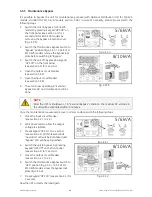
8 TROUBLESHOOTING
Whenever a malfunction occurs, first check external factors (e.g. connections, temperature, humidity or
load) to determine whether the problem is caused by the unit itself or by its environment. Subsequently
check the thermal circuit breaker: it may be tripped. If so: reset it (see fig. 3.3.5.a/b) and be sure that the
UPS is not overloaded.
The following chart is a simple troubleshooting checklist. If the suggested solution does not succeed, or if
the information is insufficient to solve the problem, please contact your dealer or consult
www.GEDigitalEnergy.com
PROBLEM
POSSIBLE CAUSE
SOLUTION
Mains switched off
Switch on mains supply
No mains voltage present
Carry out mains inspection,
consult qualified electrician
No display
No alarm
(UPS switched off)
Input fuse blown or circuit
breaker tripped
Replace fuse or reset breaker
Mains indicator not illuminating,
acoustic alarm intermittent
No mains voltage present
Read section 4.4.2 – UPS on
battery
Mains indicator not illuminating,
mains voltage present, acoustic
alarm intermittent
Input fuse blown or circuit
breaker tripped
Replace fuse or reset breaker
UPS failure
Contact UPS dealer or go to
www.GEDigitalEnergy.com
UPS over-temperature
Allow UPS to cool down
Alarm LED illuminated,
continuous acoustic alarm
Overload at UPS output
Reduce UPS load
Battery extension fuse switch is
in ‘Open’ position
Switch to ‘On’ position
Batteries are not fully charged
Charge batteries for 8 hours and
reconfirm runtime
Batteries are defective
Contact UPS dealer
Delivered runtime less than
specified
Charger is defective
Contact UPS dealer
Last load bar LED is lit, acoustic
alarm intermittent
Overload at UPS output
Reduce UPS load
Incorrect communication cable
Check whether correct cable is
used
PC interface defective or being
accessed by another service
Check if no other software is
accessing the interface
No communication between
UPS and PC
Interference on the data cable
Rearrange cables
modifications reserved
40
User manual GT Series 5/6/8/10 kVA UPS 1.0 (US)


































